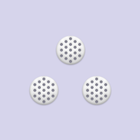❯ Looking for standard (non-aminated) silica? Click here.
Amine-functionalized silica is useful for binding studies, conjugation with carboxyl-containing molecules through EDC/NHS coupling, or binding to dyes and molecules with isothiocyanate (ITC) or amine-reactive esters. The amines at the colloid surface can be protonated at acidic pH to yield particles with a large positive zeta potential.

It is important to note that the silica on the surface of the particles grown by Stöber growth may be quite labile and can dissolve away to silicic acid species. The incomplete hydrolysis of the silane precursors may encourage this dissolution. While this may only cause the loss of some surface layers, if these layers contain the functional groups of interest the particles may lose their properties. For applications where stability of the silica shell in aqueous solutions is important, we strongly recommend using aluminosilicate shells instead of silica. Any silica shell can be transformed into an aluminosilicate shell via a proprietary solution-based method (nanoComposix patent US 9,675,953).
Advantages
- Dispersion in a wide range of solvents with a high degree of stability.
- When a silica shell is placed over a metal nanoparticle, the optical properties of the metal nanoparticle are retained even when agglomerated
- Can be dried down and redispersed without agglomeration.
- Allows the engineering of the particle surface with a wide range of functionality
- Allows engineering of controlled aggregates
- Allows exquisite control of the surface functionality
Representative Source: tetraethyl orthosilicate (Sigma Aldrich, 333859)
Property Highlights
- Not Displaceable: strongly bound to the particle surface
- Positively Charged
- Isoelectric Point: ~9
- Soluble in polar solvents
Applications
- Biodiagnostic and nanomedicine applications
- Photothermal applications
- Color applications
- Controlled aggregation
Surface Charge

See above for a representative zeta potential-pH, or Isoelectric Point (IEP) curve for silica-shelled 40 nm gold nanoparticles. This data was generated by manual titration using HCl and NaOH and subsequent measurement.
- Note: Aminated SiO2 nanoparticles have similar IEP behavior as the aminated, silica coated gold particles represented in the above data.
Aminated silica-shelled nanoparticles have high IEP’s, which means that they remain positively charged at all but the most basic of pH ranges. The magnitude of the positive charge steadily increases as the pH decreases, with protonation of the amines.
- We have demonstrated that for 40 nm gold and silver bPEI and citrate capped particles, the IEP curves are very similar.This should enable a reasonable basis for comparison of zeta potential for silver nanoparticles with the above data based on gold nanoparticles.
- For more information about zeta potential and IEP theory, click here.
Salt Stability

In the presence of a high enough salt concentration the surface charge of particles in solution can be shielded by the dissolved ions, leading to reduced colloidal stability. The ions in solution prevent the like charges from repelling one another as readily. For each particle type the salt concentration at which this destabilization occurs can be different.
The figure above provides the UV-vis spectrum of aminated silica-shelled 40 nm gold nanoparticles with different salt treatments. The samples were prepared by dilution of the particles with DI water at around pH 7 and subsequent spiking separate dispersions of nanoparticles with NaCl at the listed concentrations followed by incubation of the nanoparticle salt mixture for 10 minutes prior to UV-Vis measurement.
The strong absorption at 525 nm is indicative of non-aggregated particles. Reduction of peak intensity when salt is added is consistent with agglomeration of the particles. The data above shows that aminated, silica coated nanoparticles are colloidally destabilized at the lowest salt concentration tested, 5 mM NaCl. This type of behavior can be expected when the particles are diluted with un-buffered water, due to the fairly low magnitude zeta potential that the particles exhibit at pH 7, which is close to the IEP (see above).
The pH of the nanoparticles needs to be buffered to pH 5 or below to realize a high-magnitude, positive zeta potential and appreciable salt stability. At nanoComposix, we provide this product dispersed in ethanol, and routinely dilute with 2 mM acetate (pH 5) to perform QC tests. Under these conditions the particles are quite salt stable when the pH is buffered appropriately and exhibit remarkable stability when placed into similar acetate buffers at 100 mM in concentration. It can be assumed that the salt stability of aminated, silica coated gold nanoparticles will be similar to that of standard (non-aminated silica). See the standard silica coated nanoComposix University module here.



